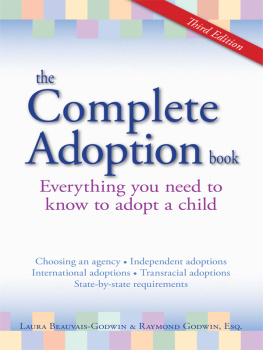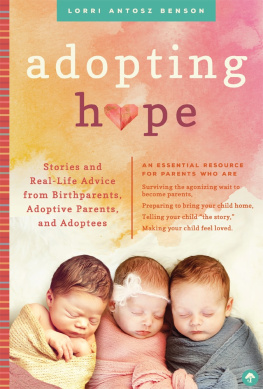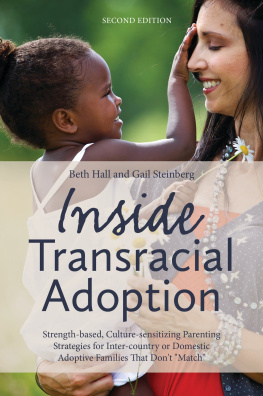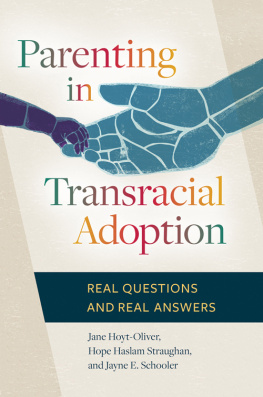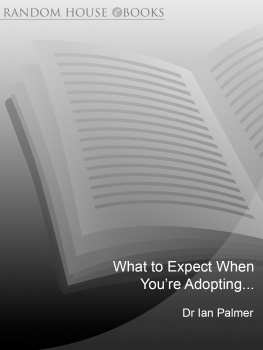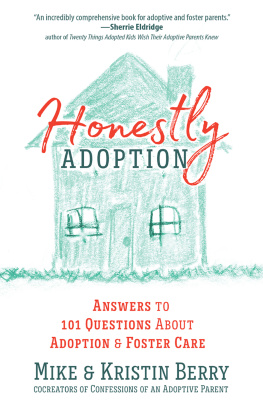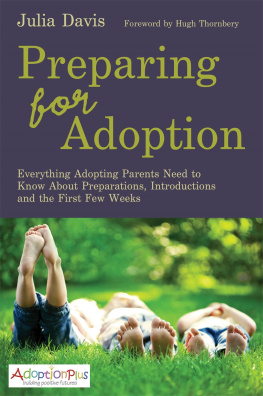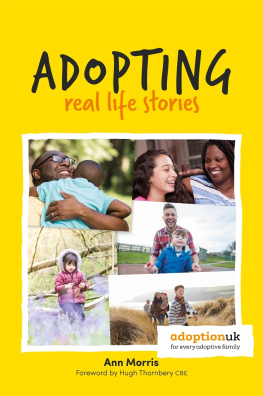The Interracial Adoption Option
Creating a Family Across Race
Marlene G. Fine and Fern L. Johnson

Jessica Kingsley Publishers
London and Philadelphia
First published in 2013
by Jessica Kingsley Publishers
73 Collier Street
London N1 9BE, UK
and
400 Market Street, Suite 400
Philadelphia, PA 19106, USA
www.jkp.com
Copyright Marlene G. Fine and Fern L. Johnson 2013
Front cover image source: iStockphoto. The cover image is for illustrative purposes only, and any person featuring is a model.
All rights reserved. No part of this publication may be reproduced in any material form (including photocopying or storing it in any medium by electronic means and whether or not transiently or incidentally to some other use of this publication) without the written permission of the copyright owner except in accordance with the provisions of the Copyright, Designs and Patents Act 1988 or under the terms of a licence issued by the Copyright Licensing Agency Ltd, Saffron House, 610 Kirby Street, London EC1N 8TS. Applications for the copyright owners written permission to reproduce any part of this publication should be addressed to the publisher.
Warning: The doing of an unauthorised act in relation to a copyright work may result in both a civil claim for damages and criminal prosecution.
Library of Congress Cataloging in Publication Data
Fine, Marlene Gail, 1949
The interracial adoption option : creating a family across race / Marlene G. Fine and Fern L. Johnson.
pages cm
Includes bibliographical references and index.
ISBN 978-1-84905-930-5 (alk. paper)
1. Interracial adoption. 2. Adoption--Psychological aspects. 3. Identity (Psychology) 4. Families. I.
Johnson, Fern L. II. Title.
HV875.6.F56 2013
306.874--dc23
2013000290
British Library Cataloguing in Publication Data
A CIP catalogue record for this book is available from the British Library
ISBN 978 1 84905 930 5
eISBN 978 0 85700 717 9
For William and Julius, and the teens and young adults who have grown up with them in our adoption group.
Contents
Acknowledgments
It does take a village. So many people helped us on our journey and provided encouragement and support as we worked on this book. We asked a number of people to read draft chapters as we completed them. Their comments were validating and also valuable in offering perspectives we had not thought of, clarifying points, and offering suggestions for resources. To those who took the time for this type of review, we are enormously grateful: Susan Beaton, Julia Demmin, Jim Gomes, Daryl Hellman, DLynn Jacobs, Mary Ann LaRoche, Dave Logan, Alex Mikulich, Kathleen Reardon, Sue Roberts, Nancy Schroeder, Brad Seamans, and Larry Seamans.
We are also grateful for friends and colleagues who have supported us throughout our adoption journey. Some were there at the very beginning and others later, but all embraced and supported our family: Betsy Astolfi, Doug Astolfi, Beverly Baccelli, Gary Bailey, Roy Bellush, Lois Brynes, Susan Copeland, Gail Dines, Christy Egun, Serena Hilsinger, Marsha Houston, Betsy Huang, Esther Jones, Fatali Karimi, Jayne Karimi, David Levy, Carol Owen, Tony Nixon, Pearl Peters, Janet Rickles, Marge Ropp, Paul Ropp, Charlena Seymour, Harry Seymour, Ruth Sharpe, Dick Traina (now deceased), Polly Traina, Arthur Young, and Frank Waldorf.
Steve Jones, our editor at JKP, was enthusiastic about our proposal and confident that we could write this book. We thank him for his interest in our work and for making everything move smoothly along the way. Everyone at JKP was helpful and prompt in answering all of our many questions. We especially thank Carolyn Holleyman, Sarah Hull, and Victoria Nicholas for their careful and supportive assistance during the various production stages of the book.
Finally, we could not have made this journey without the love and participation of our families: Marlenes parents, Fred (now deceased) and Lillian Fine; Ferns mother, Clara Johnson (now deceased); and Ferns siblings and their families. We are especially indebted to Mary and Ben Ho, Ferns sister and brother-in-law, for being the greatest aunt and uncle imaginable. Auntie Mary was there every step of the way, including flying to Massachusetts from Minnesota to take care of our children while we attended professional conferences. Our sons, William and Julius, are the center of this story. They too read draft chapters, and they listened patiently to our endless questions and thinking out loud about the book. We are so proud of how they have carried the challenges of their identities and so immensely happy that they came into our lives.
Introduction
We parked in front of the small house on a quiet street in a place we had been to once before. We sat talking, nervously wondering if we were doing the right thing. We had been together for 14 years and had a two-year-old adopted son. Could we possibly love another child as much as we loved him? We had come to this same house exactly two years before to meet our baby son, who, at four weeks old, was a gorgeous childsmiling and alert, with enormous brown eyes and impossibly long black eyelashes. He had grown into a happy, active, loving two-year-old, adored by his parents and everyone else in his life. Now we were about to adopt our second child, another boy who was described as having dreamy brown eyes and cocoa-colored skin.
We both finally took a deep breath and walked to the front door. When the social worker brought the babyour babydownstairs and put him in Ferns arms, any lingering doubts disappeared. His eyes were, indeed, as dreamy as we had been told, his little body soft and receptive, and we instantly knew he would be loved.
The story of our family began many years before this moment. It is a love story of family, friends, and community. And it is a story that we want to share in the hope that it will encourage others to be open to adopting a child, and especially to adopting one of the thousands of children of color in the U.S. and throughout the world who are waiting for families. If you are considering adoption and are white, we also hope that our story will help you decide if parenting a child of color is right for you. Our experience has been joyful and rewarding beyond measure, as we believe parenting is for most people. It has also been challenging, as we believe parenting also is for most people. We have learned a lot along the way about not only ourselves and our children, but also the culture we live in here in the U.S. Our own story and the stories of the many people we have met over the years who took similar journeys are the foundation for this book. In the chapters that follow, we offer you what we have learned, and hope that you will learn from it also. In many ways, the book is a response to what we did


